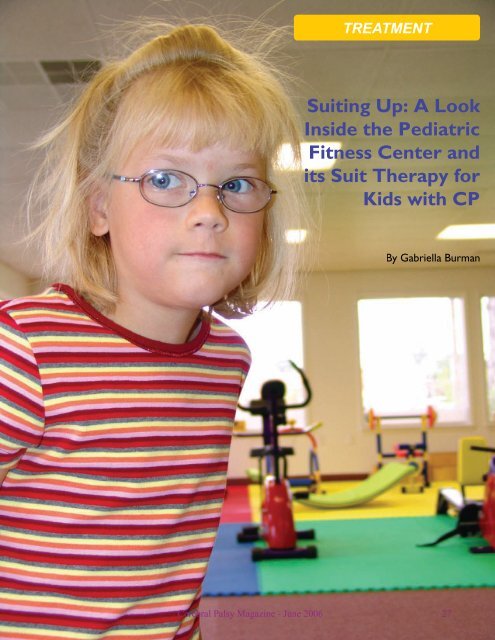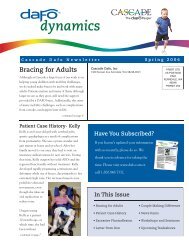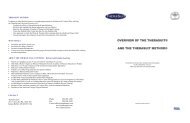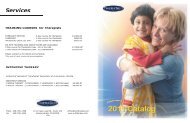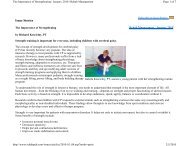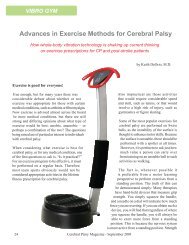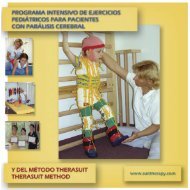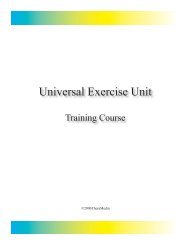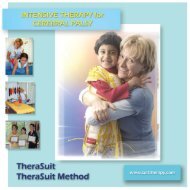Suiting Up: A Look Inside The Pediatric Fitness Center And
Suiting Up: A Look Inside The Pediatric Fitness Center And
Suiting Up: A Look Inside The Pediatric Fitness Center And
Create successful ePaper yourself
Turn your PDF publications into a flip-book with our unique Google optimized e-Paper software.
TREATMENT<br />
<strong>Suiting</strong> <strong>Up</strong>: A <strong>Look</strong><br />
<strong>Inside</strong> the <strong>Pediatric</strong><br />
<strong>Fitness</strong> <strong>Center</strong> and<br />
its Suit <strong>The</strong>rapy for<br />
Kids with CP<br />
By Gabriella Burman<br />
Cerebral Palsy Magazine - June 2006 27
TREATMENT<br />
<strong>Suiting</strong> <strong>Up</strong>: A <strong>Look</strong> <strong>Inside</strong><br />
the <strong>Pediatric</strong> <strong>Fitness</strong> <strong>Center</strong><br />
and its Suit <strong>The</strong>rapy for Kids<br />
with CP Gabriella Burman<br />
For most parents, the Magic Kingdom is at Walt Disney<br />
World in Orlando, Florida, a fantasyland populated by<br />
Mickey Mouse, Cinderella and the rest of the gang.<br />
But for parents whose children have cerebral palsy, the<br />
true magic kingdom is a light-filled, one-story building<br />
in suburban Detroit, Michigan. <strong>Inside</strong>, their children may<br />
sit unassisted for the first time, transition from walking<br />
with walkers to canes, and eventually, to walking with no<br />
assistance at all.<br />
<strong>Pediatric</strong> <strong>Fitness</strong> <strong>Center</strong>, the home base for a method of<br />
intensive physical therapy called “Suit <strong>The</strong>rapy”, has proven<br />
so effective that its owners, Richard and Izabela Koscielny,<br />
have now trained more than 2,000 physical therapists<br />
worldwide, including therapists in more than 75 facilities<br />
in the U.S.<br />
Izabela Koscielny with patient CJ Gray.<br />
<strong>The</strong> suit is a modification of an “astronaut suit” designed<br />
by Russian scientists in the 1970s that restored posture and<br />
supported weakened muscles in space in order to prevent<br />
atrophy and osteoporosis in cosmonauts.<br />
In Poland, physical therapists used the Russian suit to treat<br />
adults with CP, and after the Koscielny’s daughter, Kaya,<br />
whose premature birth in Poland in 1991 resulted in cerebral<br />
palsy, took her first steps while wearing it, the Koscielnys,<br />
who are certified physical therapists, knew they had found<br />
the way to facilitate movement in children with CP.<br />
In 2002, the couple, who had moved to the U.S. in 1994, left<br />
their jobs running a physical therapy clinic at a local Detroit<br />
hospital, and set out to patent and manufacture their own suit,<br />
and open their own facility.<br />
Richard Koscielny with patient during functional exercises.<br />
28 Cerebral Palsy Magazine - June 2006
CENTER FOR CP<br />
<strong>Pediatric</strong> <strong>Fitness</strong> <strong>Center</strong><br />
<strong>The</strong>y opened the doors to their bright and cheerfully decorated<br />
center in 2003, with an office manager and themselves<br />
working as the physical therapists. In just three years, they<br />
have added six other physical therapists to accommodate<br />
the growing demand of patients who come from around<br />
the world, while also growing the business, which includes<br />
a quarterly magazine, Cerebral Palsy, and a catalogue of<br />
pediatric fitness equipment.<br />
“I never dreamt that we’d achieve all this,” says Izabela, who<br />
as the mother of a child with cerebral palsy learned early on<br />
to “take one day at a time.”<br />
“But our method caught fire because people see results in a<br />
short time and it makes parents want to take advantage of suit<br />
therapy, and makes therapists want to open a similar facility.<br />
It’s not that they were bad therapists beforehand, they just<br />
didn’t have the right tools.”<br />
Children who participate in suit therapy at <strong>Pediatric</strong> <strong>Fitness</strong><br />
<strong>Center</strong> can sign on for a three-week intensive session<br />
that lasts three hours a day, five days a week. <strong>The</strong>y work<br />
individually with the same physical therapist for the duration<br />
Universal Exercise Units in the main gym.<br />
so that a trusting relationship can be established, and progress<br />
accurately measured. Each program is tailored to the child’s<br />
specific needs and abilities, with the major goal being range<br />
of motion and strength.<br />
“Once you have strength, you can learn function,” Izabela<br />
says. “Function is the ultimate goal.”<br />
<strong>The</strong> rationale for a three-week program, Izabela explains,<br />
“is that it takes a week to stimulate the nervous system, and<br />
then two weeks to refine motor skills.”<br />
<strong>The</strong> first hour of therapy prepares the patient for the exercises<br />
that will follow. Because it is well known that the muscles of<br />
children with CP can be less vascularized, and can contain<br />
more lactic acid - which can prevent conduction between<br />
synapses and therefore prevent learning - each session begins<br />
with laying heat packs on the child’s limbs and massaging<br />
them to increase circulation and remove lactic acid.<br />
“Once we soften the tissue, and make it more flexible, we<br />
can start range of motion and strengthening, and produce<br />
movement,” Izabela says.<br />
Individual exercise room.<br />
Main gym, exercise equipement for children and teenagers.<br />
Cerebral Palsy Magazine - June 2006 29
30 Cerebral Palsy Magazine - June 2006<br />
Simon Maciejewski with patient<br />
during walking exercises.
CENTER FOR CP<br />
<strong>The</strong> next stage includes strengthening exercises. Infants work<br />
on global movements while older children work on problem<br />
muscle groups such as elbow flexors and hamstrings, often<br />
using the center’s universal exercise unit, where various<br />
weights can be attached to provide resistance.<br />
In a study of the suit, it was determined that children who<br />
received therapy five days a week wearing the suit patented<br />
by the Koscielnys achieved gains faster than those who<br />
received therapy five days a week without it. <strong>The</strong> couple<br />
recently established a non-profit entity to raise funds for<br />
further research in the hopes that a research protocol will<br />
make insurance companies more amenable to covering<br />
the cost of suit therapy. At present, the Koscielnys do not<br />
accept any insurance; parents must submit invoices to their<br />
insurance carriers for reimbursement.<br />
In some ways, the therapy can be likened to a personal<br />
training session, as the children perform squats, lunges, situps,<br />
and other exercises that strengthen their muscles for<br />
sitting, standing and walking. Often, the first day of a session<br />
passes rather easily; as the muscles waken, however, days<br />
two and three of training can be taxing on the kids, even<br />
as the trainers remain firm and encouraging throughout the<br />
session. Parents are invited to encourage and support their<br />
children, or can retreat to a quiet parents’ room away from<br />
the action to read a magazine or watch a movie. <strong>The</strong>re is<br />
also a small waiting area filled with toys and books where<br />
siblings can play or do homework while their brothers and<br />
sisters “work out”.<br />
Lower extremities strenghtening in Universal Exercise Unit<br />
<strong>The</strong> overall environment takes into account not<br />
only the needs of children and parents, but also<br />
those of the therapists who work there.<br />
Simon Maciejewski, who primarily works with<br />
older children, received training at Central<br />
Michigan University. He says working with the<br />
CP population is “more challenging” than working<br />
with patients who have other injuries, and that it is<br />
also “more rewarding.”<br />
Furthermore, he adds, he prefers dedicated work<br />
with one child to rotating through several clients<br />
a day, as he did when he worked at larger, general<br />
physical therapy clinics.<br />
“Here you get to focus on a child, and all the<br />
therapists have a true interest in what the others<br />
are doing. It’s like a family.”<br />
Functional and strenthening exercises wearing the <strong>The</strong>raSuit.<br />
Cerebral Palsy Magazine - June 2006 31
TREATMENT<br />
Dorota Jankowski (left), Kathy Howard<br />
and Mariola Vanderest promoting<br />
<strong>The</strong>raSuit during 10 k run event,<br />
Christopher Collins<br />
Sylwia and Przemek Tokarski<br />
Mariola Vanderest obtained a master’s degree in physical<br />
therapy from the Academy of Physical Education in Warsaw.<br />
She also received neurodevelopmental training on how<br />
children typically develop, enabling her to correctly align<br />
patients and stimulate proper muscle tone to help them<br />
achieve free movements.<br />
Christopher Collins is a recent graduate of Mott Community<br />
College in Flint, Michigan., and a certified physical therapy<br />
assistant who also works with older, heavier children.<br />
“At first I expected working with kids as playtime,” he<br />
says. “But it’s really intense, hard work, and the length of<br />
treatment on a daily basis is ideal in order to see results. <strong>And</strong><br />
unlike most of my classmates, I’m not juggling patients on<br />
an hourly basis.”<br />
Dorota Jankowski is a physical therapy assistant who trained<br />
at Oakland Community College and plans to pursue a<br />
physical therapy degree at the University of Michigan. She<br />
says that unlike hospital settings, where the focus can be on<br />
the bottom line, the <strong>Pediatric</strong> <strong>Fitness</strong> <strong>Center</strong> always caters<br />
to patients’ needs.<br />
“Richard and Izabela really care about kids,” she says. “If a<br />
patient is a bit late for some reason, there is no penalty. That’s<br />
rare in a physical therapy facility.”<br />
Sylvia and Przemek Tokarski are physical therapists who<br />
recently joined the team; both have vast experience working<br />
with the Russian suits that were the basis for the Koscielny’s<br />
suit therapy. In addition to working with children, they will<br />
also work with adults in the center’s 3,000 square feet of<br />
expanded space.<br />
“<strong>The</strong>re is demand from adults who<br />
want to come here, but they don’t<br />
necessarily want to work in the<br />
same space as children,” Izabela<br />
explains.<br />
Office manager Jeanne Wallace,<br />
a former physical therapist, looks<br />
forward to the additional space.<br />
“We’re outgrowing ourselves<br />
here,” she says. “Some days it’s<br />
wall to wall kids, therapists and<br />
parents.”<br />
But the volume of patients - and the accompanying hard<br />
work - is a blessing, she adds.<br />
“It’s nice to see that Richard and Izabela are realizing their<br />
dream of helping as many parents and children as possible<br />
who are affected by neuromuscular disorders.<br />
“Most physical therapy programs teach the importance of<br />
strength training, but it’s this level of intensity,” she says,<br />
“that makes the difference.”<br />
Contact inforrmation:<br />
<strong>Pediatric</strong> <strong>Fitness</strong> <strong>Center</strong><br />
2141 Cass Lake Rd., Suite 107<br />
Keego Harbor, MI 48320<br />
Toll Free (877) 843 - 7278<br />
E-mail: office@suittherapy.com<br />
www.cpfitnesscenter.com<br />
www.suittherapy.com<br />
Jeanne Wallace<br />
32 Cerebral Palsy Magazine - June 2006


